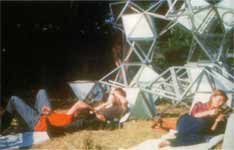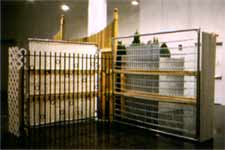For ‘Flash Art’ magazine

Reporting recently from Baghdad, writer Jon Lee Anderson described an Iraqi man’s assumption that the U.S. population was anti-war because of comments he had heard on American satellite television. This exchange suggested a game of media ping-pong, a ‘us watching them, watching us’ scenario that provided a glimpse of how information is exchanged on a global scale. This kind of sudden insight, and more obvious evidence of how the world is organized in both discrete and interlocked systems, was the subject of ‘Living Inside the Grid.’ At the core of the exhibition concept was curator Dan Cameron’s observation that “…the inhabited grid has become the irreducible sign of the world we live in today.” Cameron supported his assertion by assembling twenty-four artists or artist groups from twelve countries, whose work in some way acknowledges or interacts with the systems that order our worlds.
Surprisingly, the exhibition excluded web-informed artwork. Instead, art in a range of media explored how the concept of the grid, made so pervasive by the Internet, is reapplied to other aspects of life from the intimate to the international. Using themselves as their subject matter, Danica Phelps applied systemization to her life by logging all her art sales, expenses and activities, while the late Israeli artist Absalon videoed himself hitting and kicking at invisible bonds. An impressive sculpture, constructed of common materials used to build fences, by Monica Bonvicini and a portable group of interlocking, triangular plastic ‘Public Things’ by N55 each challenged prepackaged design for the masses. The grid extended to the international level with drawn diagrams outlining conspiracies by Mark Lombardi and a mesmerizing projection of patterns made with three letter airport abbreviations by Langlands and Bell. Rico Gatson’s collages of manipulated movie clips critiqued the dissemination of racial stereotypes, while Tomoko Takahashi’s lighthearted video of shredded paper being thrown from a tower played on a stack of nine monitors.

This exhibition proposed that grid systems are so ubiquitous that they are integral to perception and representation. However, the success of this thesis undermines the criteria for selecting artwork for the show by suggesting that most art in touch with contemporary culture would in some way replicate the grid. If fact, several pieces in the show were similar to work by artists who have been more visible recently in New York. For instance, Douglas Blau’s installation of film stills of women in bed strongly recalled Christian Marclay’s video montage and German artist Roland Boden’s portable urban shelters are similar to Andrea Zittel’s live-in units. This only serves to prove Cameron’s point, however, while reminding us that several artists can work in similar ways at one time. ‘Living Inside the Grid’ brings together a variety of diverse artwork under the theme of the grid, but viewers who took time to connect the dots will see patterns emerging in galleries across town.